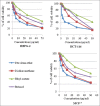Biological Activity and Isolation of Compounds from Stem Bark of Plumeria acutifolia
- PMID: 29142406
- PMCID: PMC5669089
- DOI: 10.4103/pm.pm_22_17
Biological Activity and Isolation of Compounds from Stem Bark of Plumeria acutifolia
Abstract
Background: Plumeria acutifolia (Apocynaceae) is an ornamental plant, used in the traditional medicine and known to have a variety of constituents as alkaloids, flavonoids, and iridoids. Extracts of this plant were proved to have antimicrobial and anticancer activities.
Objectives: This research was conducted for the evaluation of the biological activities of P. acutifolia stem bark and isolation and structural elucidation of various chemical compounds from the biologically active fractions.
Materials and methods: Methanol extract of stem bark of P. acutifolia was successively fractionated with petroleum ether, dichloromethane, ethyl acetate, and n-butanol. The fractions were evaluated for their antimicrobial, cytotoxic, and antioxidant activities. Fractions with promising biological activities were subjected to chromatographic techniques for the isolation of compounds, followed by structural elucidation using several spectroscopic techniques.
Results: P. acutifolia stem bark showed a significant antimicrobial activity, where the ethyl acetate fraction was active against Syncephalastrum racemosum (7.81 μg/ml) and Escherichia coli (3.9 μg/ml). The cytotoxic activity against HEPG-2, HCT-116, and MCF-7 cell lines was highest in the petroleum ether fraction, using concentrations of 1, 2.5, 5, and 10 μl/ml. The antioxidant activity was concentration dependent; ethyl acetate fraction showed the most predominant effect, with an IC50 of 197.1 μg/ml. Five compounds were identified as narcissin (1), quercitrin (2), sweroside (3), gaertneroside (4), and plumieride (5).
Conclusion: P. acutifolia was proved to have significant antimicrobial, cytotoxic, and antioxidant activities; the isolated compounds were flavonoids, iridoids, and secoiridoid, some of which were reported for the first time in genus Plumeria and/or family Apocynaceae.
Summary: P. acutifolia stem bark showed a significant antimicrobial activity, where the ethyl acetate fraction was active against Syncephalastrum racemosum and Escherichia coli. The cytotoxic activity against HEPG-2, HCT-116, and MCF-7 cell lines was highest in the petroleum ether fraction. The antioxidant activity was concentration dependent; ethyl acetate fraction showed the most predominant effect. Five compounds were identified as narcissin (1), quercitrin (2), sweroside (3), gaertneroside (4), and plumieride (5). Abbreviations used: mp: Melting point, NMR: Nuclear magnetic resonance, s: Singlet, d: Double, t: Triplet, q: Quartet, dd: Double-double, m: Multiplet, br: Broad.
Keywords: Antimicrobial; Apocynaceae; antioxidant; flavonoids; iridoids.
Conflict of interest statement
There are no conflicts of interest
Figures




Similar articles
-
Plumeria rubra L.- A review on its ethnopharmacological, morphological, phytochemical, pharmacological and toxicological studies.J Ethnopharmacol. 2021 Jan 10;264:113291. doi: 10.1016/j.jep.2020.113291. Epub 2020 Aug 22. J Ethnopharmacol. 2021. PMID: 32841700 Review.
-
ISOLATION AND CHARACTERIZATION OF CHEMICAL CONSTITUENTS FROM CHRYSOPHYLLUM ALBIDUM G. DON-HOLL. STEM-BARK EXTRACTS AND THEIR ANTIOXIDANT AND ANTIBACTERIAL PROPERTIES.Afr J Tradit Complement Altern Med. 2016 Aug 12;13(5):182-189. doi: 10.21010/ajtcam.v13i5.24. eCollection 2016. Afr J Tradit Complement Altern Med. 2016. PMID: 28487910 Free PMC article.
-
Characterization of the Phenolic Compound, Gallic Acid from Sansevieria roxburghiana Schult and Schult. f. Rhizomes and Antioxidant and Cytotoxic Activities Evaluation.Pharmacogn Mag. 2017 Oct;13(Suppl 3):S693-S699. doi: 10.4103/pm.pm_497_16. Epub 2017 Oct 11. Pharmacogn Mag. 2017. PMID: 29142435 Free PMC article.
-
Cytotoxicity Studies of the Extracts, Fractions, and Isolated Compound of Pseudocedrela kotschyi on Cervical Cancer (HeLa), Breast Cancer (MCF-7) and Skeletal Muscle Cancer (RD) Cells.Pharmacognosy Res. 2017 Jan-Mar;9(1):46-50. doi: 10.4103/0974-8490.199776. Pharmacognosy Res. 2017. PMID: 28250653 Free PMC article.
-
Phytochemical screening, phenolic and flavonoid contents, antioxidant and cytogenotoxicity activities of Combretum leprosum Mart. (Combretaceae).J Toxicol Environ Health A. 2021 May 19;84(10):399-417. doi: 10.1080/15287394.2021.1875345. Epub 2021 Jan 25. J Toxicol Environ Health A. 2021. PMID: 33494643
Cited by
-
Sweroside: unveiling broad therapeutic potential-from mechanistic insights to clinical potential.Front Pharmacol. 2025 Jul 29;16:1594278. doi: 10.3389/fphar.2025.1594278. eCollection 2025. Front Pharmacol. 2025. PMID: 40799828 Free PMC article. Review.
-
Metabolomics and Network Pharmacology in the Exploration of the Multi-Targeted Therapeutic Approach of Traditional Medicinal Plants.Plants (Basel). 2022 Nov 25;11(23):3243. doi: 10.3390/plants11233243. Plants (Basel). 2022. PMID: 36501282 Free PMC article. Review.
-
Extraction, Radical Scavenging Activities, and Chemical Composition Identification of Flavonoids from Sunflower (Helianthus annuus L.) Receptacles.Molecules. 2021 Jan 14;26(2):403. doi: 10.3390/molecules26020403. Molecules. 2021. PMID: 33466694 Free PMC article.
References
-
- Endress ME, Bruyns PV. A revised classification of the Apocynceae s.l. Bot Rev. 2000;66:1–56.
-
- Kamariah AS, Lim LB, Baser KH, Ozek T, Demirci B. Composition of the essential oil of Plumeria obtusa L. Flavour Fragr J. 1999;14:237–40.
-
- Perry LM, Metzger J. Medicinal Plants of East and Southest Asia: Attributed Properties and Uses. Cambridge: The MIT Press; 1980. pp. 28–9.
-
- Rasool SN, Jaheerunnisa S, Chitta SK, Jayaveera KN. Antimicrobial activities of Plumeria acutifolia. J Med Plants Res. 2008;2:77–80.
-
- Dobhal MP, Li G, Gryshuk A, Graham A, Bhatanager AK, Khaja SD, et al. Structural modifications of plumieride isolated from Plumeria bicolor and the effect of these modifications on in vitro anticancer activity. J Org Chem. 2004;69:6165–72. - PubMed
LinkOut - more resources
Full Text Sources
Other Literature Sources
